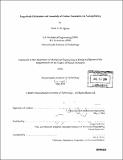Large-scale fabrication and assembly of carbon nanotubes via nanopelleting
Author(s)
El Aguizy, Tarek A., 1977-
DownloadFull printable version (12.29Mb)
Other Contributors
Massachusetts Institute of Technology. Dept. of Mechanical Engineering.
Advisor
Sang-Gook Kim.
Terms of use
Metadata
Show full item recordAbstract
Widespread use of carbon nanotubes is predicated on the development of robust large-scale manufacturing techniques. There remain, however, few feasible methods for the large-scale handling of aligned and geometrically uniform carbon nanotubes (CNTs), which has limited successful commercial applications to date. This thesis investigates a process, termed nanopelleting, for the handling and assembly of CNTs that allows integration into multi-scale systems with direct control over CNT length, alignment, and position over large areas. Conceptually, a nanopellet consists of a CNT embedded within a micro-scale block. The block serves as a micro-scale transport vehicle, or carrier, for the nanostructure, facilitating the assembly of CNTs into micro and macro-scale systems. Further, the pellets provide control over the alignment and length of the CNT, attenuating the effects of fluctuating process conditions normally associated with CNT growth. Moreover, nanopellets provide a seeding mechanism whereby CNTs can be grown and subsequently harvested; this enhances control over yield, enabling the fabrication of devices with large areas of high-quality CNTs. Several fabrication process flows are developed and tested for creating pellets. Actual pellets with embedded CNTs are fabricated and transplanted onto different substrates. The results support the merit of nanopelleting as a means of controlling CNTs, which represents an efficient method for growth and deterministic handling of an individual CNT. Further work on optimized pellet design and linking the nanopelleting concept with assembly methods and actual applications would be useful.
Description
Thesis (S.M.)--Massachusetts Institute of Technology, Dept. of Mechanical Engineering, 2004. Includes bibliographical references (p. 79-83).
Date issued
2004Department
Massachusetts Institute of Technology. Department of Mechanical EngineeringPublisher
Massachusetts Institute of Technology
Keywords
Mechanical Engineering.